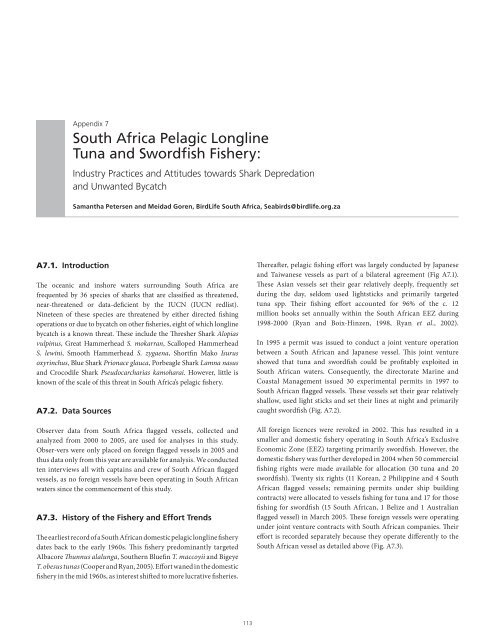Shark Depredation and Unwanted Bycatch in Pelagic Longline
Shark Depredation and Unwanted Bycatch in Pelagic Longline
Shark Depredation and Unwanted Bycatch in Pelagic Longline
You also want an ePaper? Increase the reach of your titles
YUMPU automatically turns print PDFs into web optimized ePapers that Google loves.
Appendix 7<br />
South Africa <strong>Pelagic</strong> Longl<strong>in</strong>e<br />
Tuna <strong>and</strong> Swordfish Fishery:<br />
Industry Practices <strong>and</strong> Attitudes towards <strong>Shark</strong> <strong>Depredation</strong><br />
<strong>and</strong> <strong>Unwanted</strong> <strong>Bycatch</strong><br />
Samantha Petersen <strong>and</strong> Meidad Goren, BirdLife South Africa, Seabirds@birdlife.org.za<br />
A7.1. Introduction<br />
The oceanic <strong>and</strong> <strong>in</strong>shore waters surround<strong>in</strong>g South Africa are<br />
frequented by 36 species of sharks that are classified as threatened,<br />
near-threatened or data-deficient by the IUCN (IUCN redlist).<br />
N<strong>in</strong>eteen of these species are threatened by either directed fish<strong>in</strong>g<br />
operations or due to bycatch on other fisheries, eight of which longl<strong>in</strong>e<br />
bycatch is a known threat. These <strong>in</strong>clude the Thresher <strong>Shark</strong> Alopias<br />
vulp<strong>in</strong>us, Great Hammerhead S. mokarran, Scalloped Hammerhead<br />
S. lew<strong>in</strong>i, Smooth Hammerhead S. zygaena, Shortf<strong>in</strong> Mako Isurus<br />
oxyr<strong>in</strong>chus, Blue <strong>Shark</strong> Prionace glauca, Porbeagle <strong>Shark</strong> Lamna nasus<br />
<strong>and</strong> Crocodile <strong>Shark</strong> Pseudocarcharias kamoharai. However, little is<br />
known of the scale of this threat <strong>in</strong> South Africa’s pelagic fishery.<br />
A7.2. Data Sources<br />
Observer data from South Africa flagged vessels, collected <strong>and</strong><br />
analyzed from 2000 to 2005, are used for analyses <strong>in</strong> this study.<br />
Obser-vers were only placed on foreign flagged vessels <strong>in</strong> 2005 <strong>and</strong><br />
thus data only from this year are available for analysis. We conducted<br />
ten <strong>in</strong>terviews all with capta<strong>in</strong>s <strong>and</strong> crew of South African flagged<br />
vessels, as no foreign vessels have been operat<strong>in</strong>g <strong>in</strong> South African<br />
waters s<strong>in</strong>ce the commencement of this study.<br />
A7.3. History of the Fishery <strong>and</strong> Effort Trends<br />
The earliest record of a South African domestic pelagic longl<strong>in</strong>e fishery<br />
dates back to the early 1960s. This fishery predom<strong>in</strong>antly targeted<br />
Albacore Thunnus alalunga, Southern Bluef<strong>in</strong> T. maccoyii <strong>and</strong> Bigeye<br />
T. obesus tunas (Cooper <strong>and</strong> Ryan, 2005). Effort waned <strong>in</strong> the domestic<br />
fishery <strong>in</strong> the mid 1960s, as <strong>in</strong>terest shifted to more lucrative fisheries.<br />
Thereafter, pelagic fish<strong>in</strong>g effort was largely conducted by Japanese<br />
<strong>and</strong> Taiwanese vessels as part of a bilateral agreement (Fig A7.1).<br />
These Asian vessels set their gear relatively deeply, frequently set<br />
dur<strong>in</strong>g the day, seldom used lightsticks <strong>and</strong> primarily targeted<br />
tuna spp. Their fish<strong>in</strong>g effort accounted for 96% of the c. 12<br />
million hooks set annually with<strong>in</strong> the South African EEZ dur<strong>in</strong>g<br />
1998-2000 (Ryan <strong>and</strong> Boix-H<strong>in</strong>zen, 1998, Ryan et al., 2002).<br />
In 1995 a permit was issued to conduct a jo<strong>in</strong>t venture operation<br />
between a South African <strong>and</strong> Japanese vessel. This jo<strong>in</strong>t venture<br />
showed that tuna <strong>and</strong> swordfish could be profitably exploited <strong>in</strong><br />
South African waters. Consequently, the directorate Mar<strong>in</strong>e <strong>and</strong><br />
Coastal Management issued 30 experimental permits <strong>in</strong> 1997 to<br />
South African flagged vessels. These vessels set their gear relatively<br />
shallow, used light sticks <strong>and</strong> set their l<strong>in</strong>es at night <strong>and</strong> primarily<br />
caught swordfish (Fig. A7.2).<br />
All foreign licences were revoked <strong>in</strong> 2002. This has resulted <strong>in</strong> a<br />
smaller <strong>and</strong> domestic fishery operat<strong>in</strong>g <strong>in</strong> South Africa’s Exclusive<br />
Economic Zone (EEZ) target<strong>in</strong>g primarily swordfish. However, the<br />
domestic fishery was further developed <strong>in</strong> 2004 when 50 commercial<br />
fish<strong>in</strong>g rights were made available for allocation (30 tuna <strong>and</strong> 20<br />
swordfish). Twenty six rights (11 Korean, 2 Philipp<strong>in</strong>e <strong>and</strong> 4 South<br />
African flagged vessels; rema<strong>in</strong><strong>in</strong>g permits under ship build<strong>in</strong>g<br />
contracts) were allocated to vessels fish<strong>in</strong>g for tuna <strong>and</strong> 17 for those<br />
fish<strong>in</strong>g for swordfish (15 South African, 1 Belize <strong>and</strong> 1 Australian<br />
flagged vessel) <strong>in</strong> March 2005. These foreign vessels were operat<strong>in</strong>g<br />
under jo<strong>in</strong>t venture contracts with South African companies. Their<br />
effort is recorded separately because they operate differently to the<br />
South African vessel as detailed above (Fig. A7.3).<br />
113












